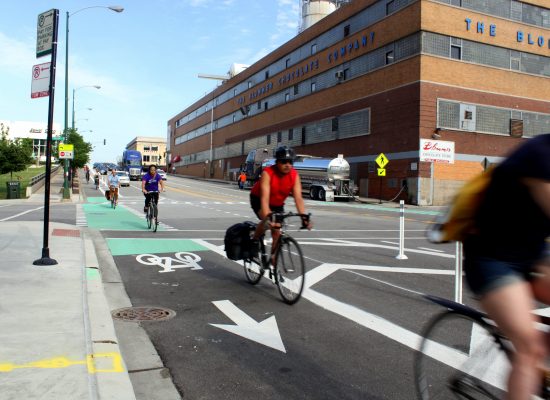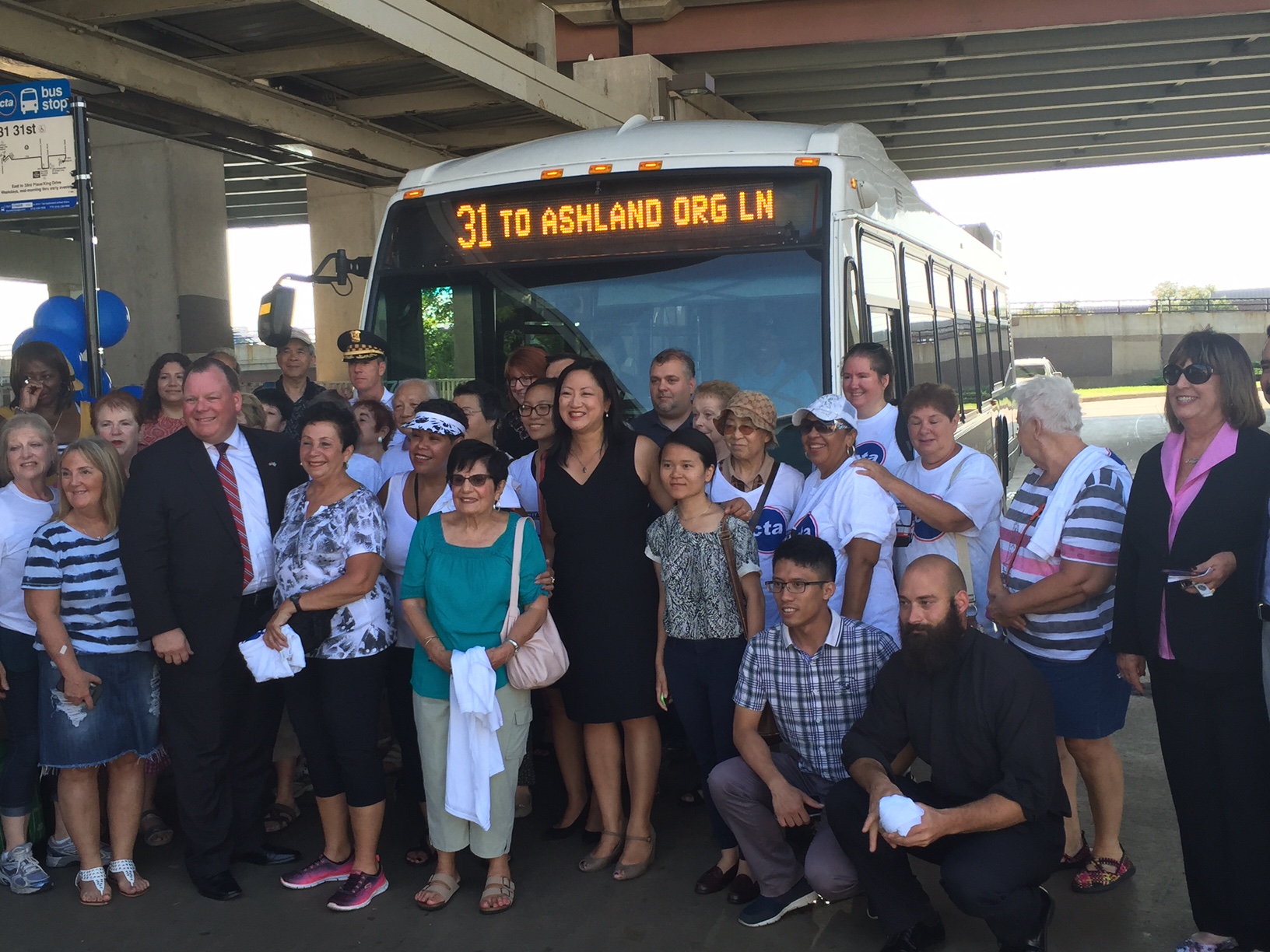
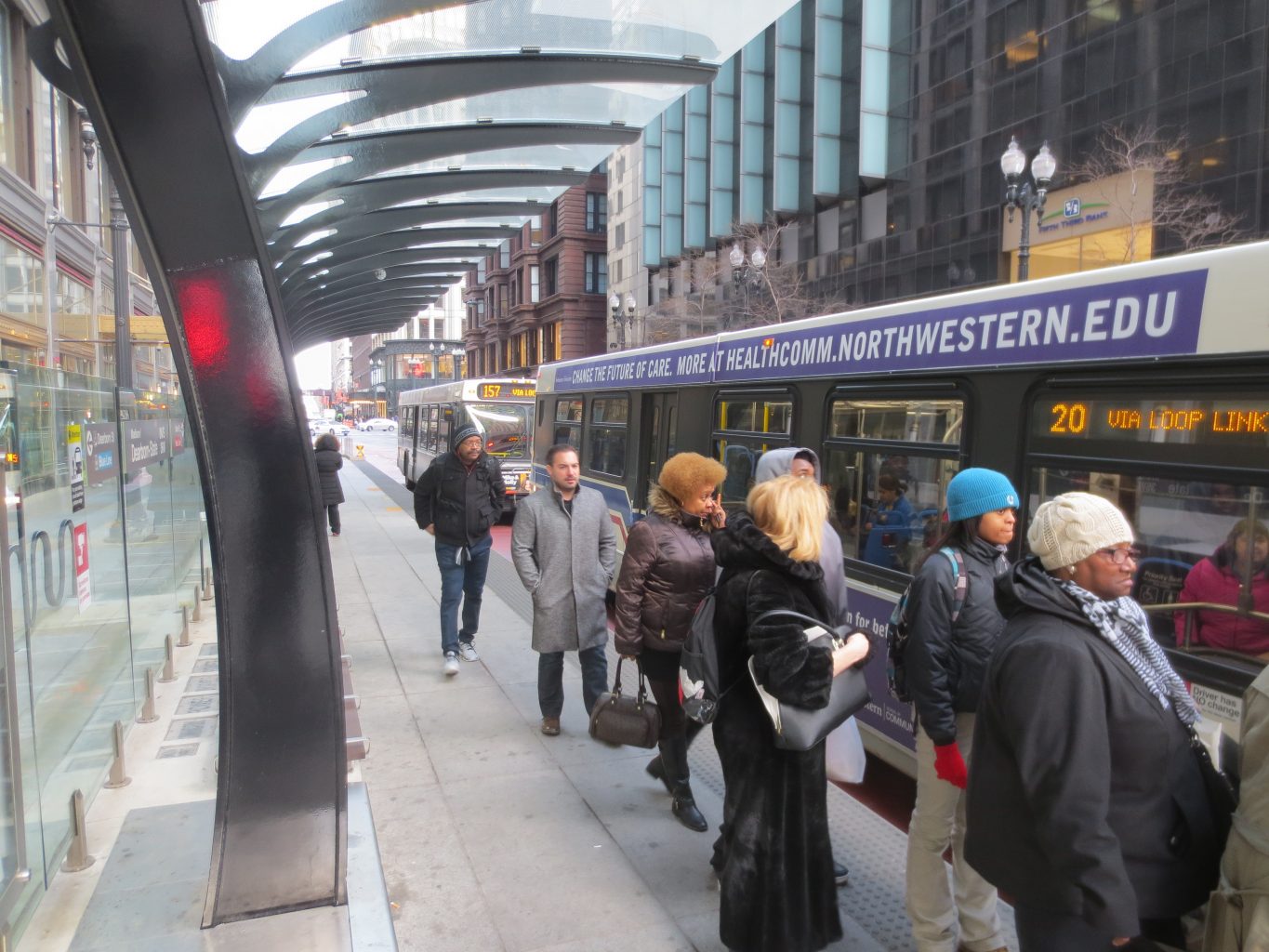 TransitCenter staff recently sat down with Ron Burke and Kyle Whitehead of Active Transportation Alliance (ActiveTrans), Chicago’s bike, walk and transit advocacy organization. Ron is Active Transportation Alliance’s executive director and Kyle serves as policy director. Active Transportation Alliance was founded in 1985 as the Chicagoland Bike Federation, and was renamed in 2008 to include walking and transit. TransitCenter is supporting Active Trans’ “Making Chicago Buses Faster” campaign in a national competition of applicants during our annual Open Call for Grants.
TransitCenter staff recently sat down with Ron Burke and Kyle Whitehead of Active Transportation Alliance (ActiveTrans), Chicago’s bike, walk and transit advocacy organization. Ron is Active Transportation Alliance’s executive director and Kyle serves as policy director. Active Transportation Alliance was founded in 1985 as the Chicagoland Bike Federation, and was renamed in 2008 to include walking and transit. TransitCenter is supporting Active Trans’ “Making Chicago Buses Faster” campaign in a national competition of applicants during our annual Open Call for Grants.
How do you view the Chicago transportation landscape of today?
Ron Burke: Leaders in the City of Chicago get it. Policy leaders and business leaders understand how biking, walking and transit are interconnected, and how they work to create vibrant cities that don’t rely on cars. Chicagoland continues to be hamstrung by the low-density neighborhoods throughout the city and region and the accompanying radial, hub-and-spoke rail transit system. The spokes are not sufficiently connected by decent rapid transit. If you’re not going downtown, it’s difficult to make transit work for you.
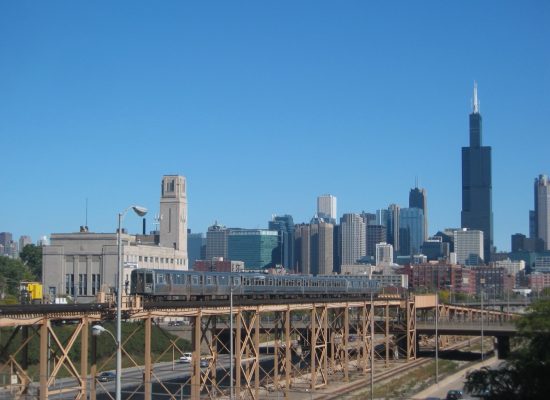
Another Douglas Train by Kevin Zolkiewicz is licensed under CC by 2.0
We’re also challenged by having way too many units of government. There are 275 suburbs, all reliant on property tax revenue which increases competition for things like big-box stores. However, more and more the suburbs are understanding their need to be more bike, walk and transit friendly. A major wake up call was big companies moving back downtown. For example, last year McDonald’s decided to move their headquarters to Downtown from a beautiful sprawling campus in DuPage County.
That’s the good news. The bad news is they’ve dug themselves a hole. But you can retrofit sprawl a bit and we do have really good rail lines out to the suburbs that can be integrated into a different vision of the future.
On the transit side we have a lot of potential. Chicago has this great street network and a solid rail system, and if we can connect rail through better bus service that’s obviously the low hanging fruit. We could be doing much better with relatively low investment and inconvenience. That’s what gets us excited about Making Chicago Buses Faster. There’s a lot that can be done, but we have to overcome political barriers. Fortunately we’ve got Mayor [Rahm] Emanuel for at least another two years and he’s very supportive of this type of effort.
Can you speak more about conceiving of the Making Chicago Buses Faster Project?
Kyle Whitehead: Making Chicago Buses Faster was informed by the Ashland bus rapid transit project, which was a learning experience for us as advocates and for CTA in terms of how the project was rolled out and covered in the media. We’ve seen more success in recent years relying on an advocacy model that is focused on incremental low-cost improvements, especially in a political climate where funds are so limited.
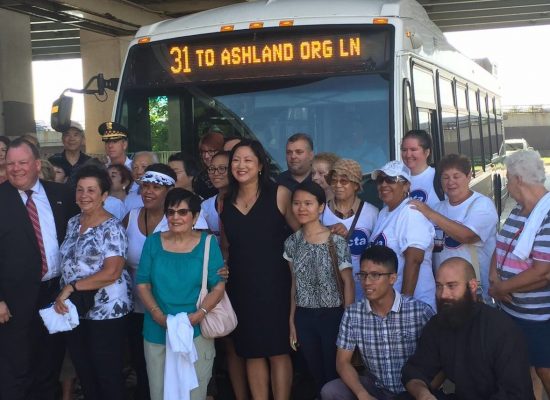
Kinzie Street Protected Bike Lane by Josh Koonceis licensed under CC BY 2.0
Bus ridership has declined 10% in the last 3 years in Chicago. There’s a wealth of factors contributing to this decline. Service cuts are a part of it – CTA has had to roll back service a number of times, which hurts ridership – but a big part of it is quality of the service.
What we’re talking about is breaking through the choice/ non-choice riders dichotomy. When infrequent riders have a disappointing experience using the bus, they’re not likely going to go back, even when it would be a good option for their trip. Bus service in Chicago has a perception issue, especially among those who have the ability to choose other modes.
So if you make your public arguments around improving speed, efficiency and reliability using strategies like all-door boarding, transit signal priority, and dedicated lanes, people are more likely to embrace those incremental changes. It’s also more affordable because you don’t have to roll it out with the same investment as when you’re rolling out a “gold-standard” BRT project. We’re still really focused on Ashland, but we believe that the types of improvements that we want on Ashland could
be applied to a dozen corridors around the city. By doing so, you can really make an impact in terms of ridership not just in one area, but around the whole system.
We’re also enthusiastic about this work because of the communities it will impact the most. We’re one of the most segregated cities in the country. The communities that are wholly reliant on bus service are suffering from decades of disinvestment and a multitude of challenges. So if you can use transportation to help improve those communities and increase job access, you’re talking about the potential for system-wide structural change in a part of the region that really needs it: the South Side and the South Suburbs.
It’s been nearly a year since the Loop Link dedicated bus lanes were launched. How’s the response?
Kyle: Loop Link has been helpful because everyone was initially concerned that it would worsen traffic. Now the conversation around that project isn’t about the traffic, it’s about the quality of bus service. People are disappointed that Loop Link is not speeding up buses at the level they hoped. That’s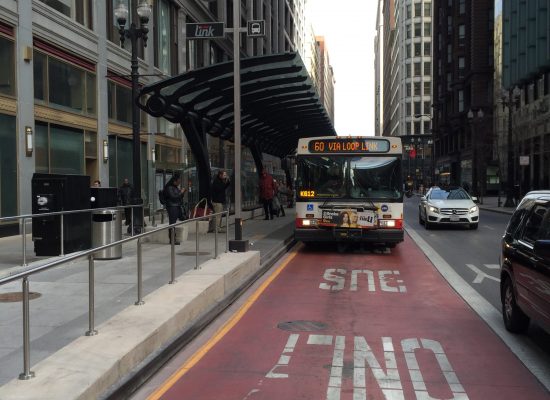 the conversation we want to be having.
the conversation we want to be having.
Nobody is saying that they should give the lane back to cars, but Loop Link was always going to be a challenge because it’s a short corridor through the densest part of the city. So there are unavoidable obstacles in terms of enforcement and pick up and drop off. The travel-time impacts were not going to be as transformational as, say, a longer corridor through many communities like we’re talking about on Ashland.
The Loop Link pre-board payment pilot is relatively new. Another preboard payment pilot that’s been working longer is at the Belmont Blue Line station, a major transfer point. The model for the pilot is to set up corrals at the station with staff on hand to ensure that people are tapping their cards. When they successfully tap they can enter the corral, and when the bus pulls up, they can enter the bus using any door, making boarding much faster. However, that model is not sustainable from a labor cost perspective. Hopefully as time passes and more data comes in, we’ll be able to make the case for the technological investments that will enable these types of projects to scale up.
One thing that gives us hope is that CTA isn’t the only transit agency having this conversation. Partially because of TransitCenter’s work, there’s a national conversation taking place not just around preboard payment but the other types of incremental improvements we’re pushing. CTA hears that conversation happening and wants to be a part of it too–a bit of peer to peer competition. If the CTA sees other agencies doing it successfully it helps our cause here.
How do you build enthusiasm around a project like Ashland Bus Rapid Transit corridor has had trouble achieving momentum?
Kyle: We’ve remained in touch with many of the community organizations along the corridor, some of whom were highly critical of the “gold” standard proposal. Some of them do recognize the need to improve transit service. They were convinced that the Ashland proposal was not the right solution, but they aren’t arguing that nothing should be done.
So re-engaging those communities through a series of incremental improvements is the way to build momentum. And CTA is already doing some of these, such as stop optimization and signal priority. As people experience those benefits, they become excited for more.Many did not embrace the gold-standard proposal in the way they are responding to lower-profile but meaningful improvements.
How does being an organization covering several modes change your approach, and what would you recommend to other organizations like the Minneapolis Bike Coalition who are broadening their mission?
Ron: I get asked that question all the time. My recommendation is typically that organizations should take the plunge. If the DNA of your organization is more that of a bike club that does advocacy, then maybe not. But if you’re first and foremost an advocacy organization and you’re in a decent-sized city where you can raise money and have enough members to get behind that multimodal mission, it’s worth it. It adds more credibility in the eyes of a lot of people, and shows you’re about sustainability and creating a vibrant city. You can wrap all these things into multimodal advocacy that you can’t when your mission is only focused on bikes.
When I first started working with the Chicagoland Bicycle Federation, the reaction you would often get was “Oh you’re a bike club. So where do you all ride?” And I would be like “We’re not that type of bike club, we do this and that” and they would respond “Oh really…. So where do you ride?” People just wouldn’t get it. So when we became the Active Transportation Alliance, people would respond with “Biking, walking and transit..oh I get it!”
Being multimodal definitelyhurt the credibility with some of the most ardent [bicycle] advocates who thought it was watering down the mission, but I think people got over that for the most part. We probably do more than we’ve ever done for cycling, even though we work on the other modes. We’re not 100% biking, but we’re able to put more resources into biking than we used to. We used to be a much smaller organization 10-15 years ago but now we’re close to 30 full-time staff.
In fact the Bicycle Transportation Alliance in Portland just went to a multimodal mission–they are becoming The Street Trust. They have the same problem we do — no one can ever remember our name! Chicagoland Bicycle Federation was so much easier to remember. So that’s one of the challenges of being multi-modal — it’s more difficult to pick a name.
 On the Brink: Will WMATA’s Progress Be Erased by 2024?
On the Brink: Will WMATA’s Progress Be Erased by 2024?
The experience of being a WMATA rider has substantially improved over the last 18 months, thanks to changes the agency has made like adding off-peak service and simplifying fares. Things are about to get even better with the launch of all-door boarding later this fall, overnight bus service on some lines starting in December, and an ambitious plan to redesign the Metrobus network. But all of this could go away by July 1, 2024.
Read More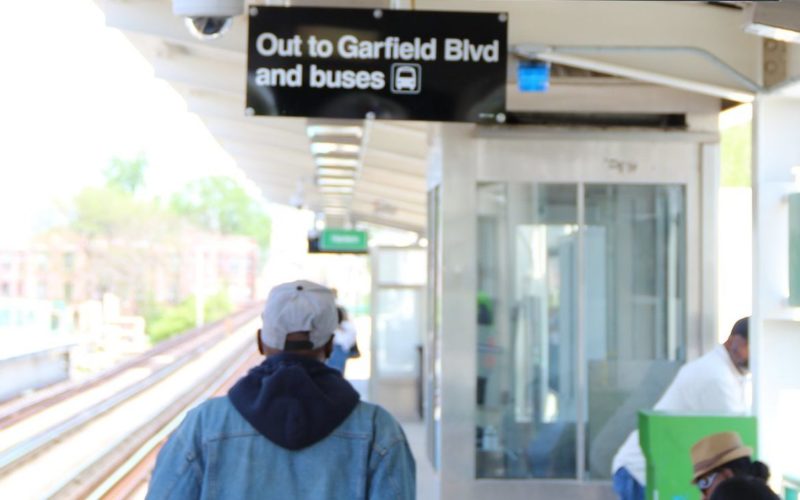 What’s Going on With Transit Service at the Seven Highest Ridership U.S. Cities? Chicago Edition
What’s Going on With Transit Service at the Seven Highest Ridership U.S. Cities? Chicago Edition
November 2021 marked a downward shift for service delivery at CTA, and the agency has not recovered as strongly as might have been expected, given its early-pandemic track record.
Read More